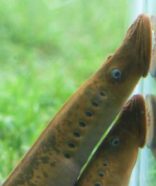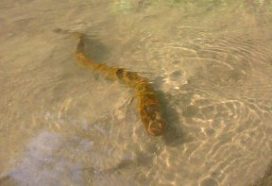Smelly Traps for Lampreys
Researchers tap into a sea lamprey's sense of smell to keep these fish under control.
Share this:
- Share via email (Opens in new window) Email
- Click to share on Facebook (Opens in new window) Facebook
- Click to share on X (Opens in new window) X
- Click to share on Pinterest (Opens in new window) Pinterest
- Click to share on Reddit (Opens in new window) Reddit
- Share to Google Classroom (Opens in new window) Google Classroom
- Click to print (Opens in new window) Print
By Emily Sohn
Sea lampreys might be nobody’s best friend. The snakelike fish are parasites. They latch onto other fish and suck their blood. Sea lampreys are also invaders. About a century ago, they arrived in the Great Lakes. By the 1940s, they had nearly wiped out many populations of native fish.
Since then, the Great Lakes Fishery Commission has spent many millions of dollars on attempts to control lampreys in the Great Lakes. The fish are a hearty bunch. Now, scientists from the University of Minnesota have found a new way to keep the destructive creatures at bay. They’re tapping into a lamprey’s sense of smell.
 |
|
Two sea lampreys cling to the glass wall of a laboratory tank. |
| University of Minnesota |
As larvae, sea lampreys spend up to 20 years in freshwater streams, where they eat and grow. Then, nearing adulthood, they move to a larger body of water, where they feed off one fish after another, for about a year. Finally, they swim to streams to mate. After a few weeks of breeding and laying eggs, they die.
Scientists have long suspected that lampreys follow the scent of each other’s pheromones, or body chemicals, to find suitable streams for mating.
 |
|
An adult sea lamprey, about 1 meter long, swims to a spawning site. |
| University of Minnesota |
To sort out which particular chemicals attract lampreys, the University of Minnesota researchers began with 8,000 liters (210 gallons) of water that had contained about 35,000 baby lamprey larvae. The scientists concentrated the liquid until they had just a few grams of gunk. They separated the gunk into individual chemical components, or compounds. Then, they tested each compound to see how lampreys responded to it.
The study turned up three compounds that both affected the lamprey’s sense of smell and attracted the fish. It was the first time that scientists have identified pheromones that affect migration in any vertebrate (animal with a backbone).
 |
|
University of Minnesota researcher Peter Sorensen holds a sea lamprey. |
| David Hansen |
After the researchers figured out which chemicals matter, they were able to create one of the compounds in the lab. If they can find a way to make the compound in large quantities, the scientists hope they’ll be able to use it to attract lampreys away from their breeding grounds. This would prevent the lampreys from reproducing, which would reduce their numbers and their impact.
Mimicking the lamprey’s scent could be a cheap and efficient way to reclaim the Great Lakes from a pesky parasite.—E. Sohn
Going Deeper:
Cunningham, Aimee. 2005. Whiff weapon: Pheromone might control invasive sea lampreys. Science News 168(Nov. 12):308-309. Available at http://www.sciencenews.org/articles/20051112/fob4.asp .
You can learn more about the sea lamprey at www.seagrant.wisc.edu/greatlakesfish/sealamprey.html (Wisconsin Sea Grant) and www.science.mcmaster.ca/Biology/Harbour/
SPECIES/SEALAMP/TITLE.HTM
(McMaster University).






